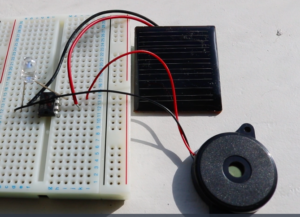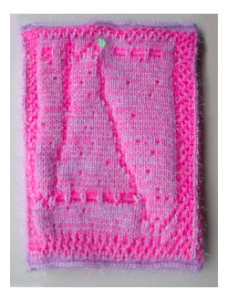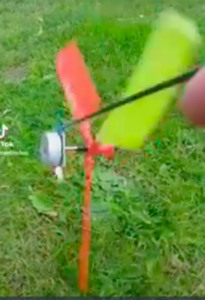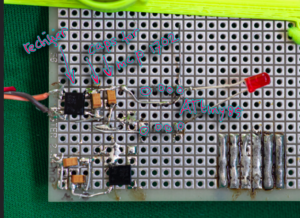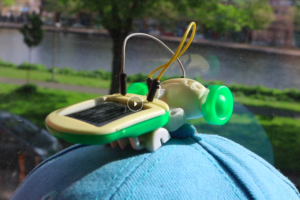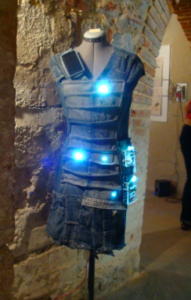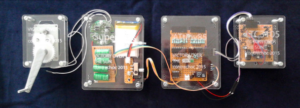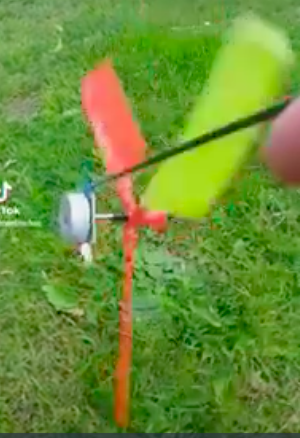- Living Station Inspiration
About Energy Domains, what can and cannot charge your smart phone
Can “anything” which produces “electricity” charge my smart phone?
A solar cell produces electricity, so it should charge my smart phone, or not?
For example – ask yourself which of these project could charge your smart phone:
- The dress from solar fiber, amongst others by by-wire.net: http://www.solarfiber.nl/nl/
- The solar shirt of Pauline van Dongen: https://www.paulinevandongen.nl/portfolio/solar-shirt/
- A solar cell phone charger: check out the internet for “the best solar phone charger”
- A donkey with a solar panel in Izmir, Turkey: https://www.aa.com.tr/en/economy/donkeys-carry-solar-panels-in-turkish-mountains/142742
- A solar cell you made yourself with titanium dioxide: https://www.youtube.com/watch?v=8hertoGXWtE
- moss plants? https://biophotovoltaics.wordpress.com
- your mud cell?
- the DIY propellor you see in the image to the right?
Answers: (as always with solar power – there has to be sun, otherwise…but say what are the answers if the sun is really shining!
- no, no, no!
- maybe…sometimes, a little bit.
- maybe but a little bit yes – depending on the Sun, that is is it winter or summer…
- yes
- no, no, no
- no, no, no, no, no
- no, no, no, no, nooooooooooooo
- no, no, no
Now why is it so difficult to charge that all important device in our life? Because this dear companion uses quite a lot of energy…
And not all sources produce enough real usable energy.
Plants really live on a tiny bit of energy compared to our smart phones. So, yes, plants produce energy, but no, don’t expect one plant, or even a lot of plants, to be able to charge your current smart phone. That for the moss plants…
To charge our cell phone we would need about the energy of a day’s work a human can produce! According to this citation, which claims that a human can produce as much energy as a square meter of solar panel.
- Een mens kan op een zonnige dag minstens zoveel energie opwekken als een zonnepaneel van 1m2.
https://www.huisvandetoekomst.org/de-toekomst
The solar shirt of Pauline van Dongen has “the problem” that it will be worn, carried around, and will not always be in the right angle to rays of the Sun. Pauline showed a picture where she rather hangs the shirt on a wall facing the Sun, making it again into a static solar panel! (Lats Friday during the The Solar Biennale Opening Seminar @ Het Nieuwe Instituut September 9th).
The titanium dioxide cell you can make yourself produces only tiny amounts of either Volts or milliamps, (but we even need to multiply these two numbers…). The same goes for the mud cells.
To generate the amount of energy “we” need, indeed at least the square meters of solar cells you see on all the roofs nowadays, or the big wind turbines, the solar farms…
Why are we still bothering about the smaller domains?
Because for instance sending data costs only a very small amount of energy. And transfer of information is as important as “real” energy.
This is well explained in two excellent BBC documentaries presented by Professor Jim Al-Khalili:
- 1 About Order Disorder: https://www.youtube.com/watch?v=aeaQpuYPsy8
- 2 About Information: https://www.youtube.com/watch?v=qj7HH0PCqIE
If you need to send data, you can use totally other energy sources, much smaller, which cannot charge your smart phone, but could save the world anyway!
This is the domain of energy harvesting: collecting small amounts of energy, and when you have enough – send your data!
- Tribo electric, rubbing Teflon etc
- for example: Peppermill
- Vibrations using piezo elements
- Peltier element using temperature differences
- for example:funny demo movie
For data transfer you can use – of course – also smaller solar cells.
Small amount of energy fun:
or make music and sounds using the solar cell (no battery!) in my windowsill:
In 2015 I made a knitting for the E-textile Swatch Exchange, combined with plastic generating enough energy to flash a LED:
http://etextile-summercamp.org/swatch-exchange/flash-knit/
I did an experiment with a Peltier element, where the warmth of my hand provides the energy to make a LED flash:
For the preparation of the elective Kites & Energy in 2022 I used a propeller and a small dynamo on a kite to make a LED flash – and using a microcontroller, this became a Morse Code ….
The Morse Code sending circuit:
You see in this video that blowing on the ventilator on the dynamo produces a signal visible on the Oscilloscope: it is enough t0 give a microcontroller energy to make an LED send a Morse Code in flashes:
You can run small motors on the sun: again in my windowsill in the Spring of 2022:
See also my post on the Interaction Station Wiki: http://interactionstation.wdka.hro.nl/wiki/Design_and_Energy_Harvesting_research
Calculations
In order to be able to make your project work you need to calculate what energy you need. Then you have to choose from the possibilities available which source will deliver that energy. Also you have to consider the circumstances. You can think the Sun will be able to deliver the energy , but if you will use your design product in Holland the Sun is not always available, so you need to consider alternatives. Power Law: P = V * I, power equals volt times current.
Energy Law : E = P * s, total energy is power times the number of seconds you apply this power.
Ohm’s Law: V = I * R, Voltage equals Current times resistance.
As a calculating example: http://interactionstation.wdka.hro.nl/wiki/Energy_calculation_example_1
And yes, really doing calculations becomes more and more complex…(even for the sending of simple data):
More in depth, calculations for a solar cell: http://interactionstation.wdka.hro.nl/wiki/Solar_cell, there you meet the Maximum Power Point Relation!
For instance, my Victory over the Sun garment, a battle agains a solar cell – presented in 2015 in France:
The dress can generate energy by a hand crank and by a solar cell. The challenge is to generate more energy than the solar cell…easy in the dark of course, but not soo simple in the ferocious rays of the sun!
More pictures can be found here: https://www.flickr.com/photos/contrechoc/albums/72157689160056833, where you can see that also the electronics involved was a battle, using energy harvesting chips and supercaps…
One of the unexpected problems which I had to solve was how to get rid of the last bit of energy after the game was played. It turned out to be rather difficult to start at zero Volt again, that is, to get all the energy out of the energy storing supercaps. A bit like getting rid of a few kilo’s of unnecessary bodyweight :-).
